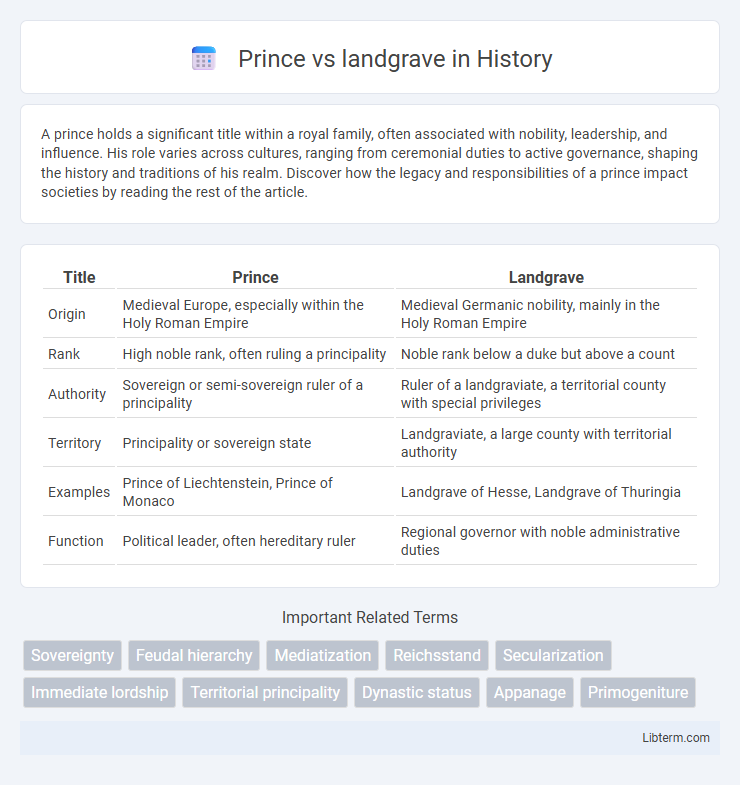A prince holds a significant title within a royal family, often associated with nobility, leadership, and influence. His role varies across cultures, ranging from ceremonial duties to active governance, shaping the history and traditions of his realm. Discover how the legacy and responsibilities of a prince impact societies by reading the rest of the article.
Table of Comparison
| Title | Prince | Landgrave |
|---|---|---|
| Origin | Medieval Europe, especially within the Holy Roman Empire | Medieval Germanic nobility, mainly in the Holy Roman Empire |
| Rank | High noble rank, often ruling a principality | Noble rank below a duke but above a count |
| Authority | Sovereign or semi-sovereign ruler of a principality | Ruler of a landgraviate, a territorial county with special privileges |
| Territory | Principality or sovereign state | Landgraviate, a large county with territorial authority |
| Examples | Prince of Liechtenstein, Prince of Monaco | Landgrave of Hesse, Landgrave of Thuringia |
| Function | Political leader, often hereditary ruler | Regional governor with noble administrative duties |
Understanding the Titles: Prince and Landgrave
A prince is a royal title typically signifying sovereignty or membership in a royal family, often with ruling authority over a principality. A landgrave is a noble title historically used in the Holy Roman Empire, denoting a count with jurisdiction over a specific territory, ranking below a prince but above a count. Understanding the distinction between prince and landgrave requires recognizing the prince's higher hereditary rank and broader political power compared to the landgrave's regional noble status.
Historical Origins of Princes and Landgraves
Princes and landgraves both emerged from medieval European nobility, with princes often ruling sovereign territories or principalities, notably within the Holy Roman Empire. Landgraves originated as counts with extended authority over larger territories, especially in Germanic regions, holding judicial and administrative powers directly from the emperor. Their historical significance reflects the complex feudal hierarchy and territorial governance in medieval Central Europe.
Geographic Regions Where Titles Were Used
The title "Prince" was predominantly used across various European regions, including the Holy Roman Empire, Russia, and parts of Italy, symbolizing sovereign or semi-sovereign rulers of principalities or small states. The title "Landgrave" specifically originated in the Holy Roman Empire, primarily in German-speaking regions such as Hesse and Thuringia, referring to a noble ruler of a county with certain administrative and judicial powers. Geographic usage of these titles reflects the political and territorial organization of medieval and early modern Europe, with "Prince" having broader application across multiple kingdoms and "Landgrave" being more regionally confined to Germanic territories.
Differences in Noble Authority and Power
A prince typically holds sovereign authority over a principality, exercising independent political power, whereas a landgrave governs a landgraviate as a noble rank within the Holy Roman Empire, often subordinate to higher imperial structures. Princes possess the right to mint coins, levy taxes, and maintain armies autonomously, contrasting with landgraves who may have limited jurisdiction and fewer autonomous privileges. The distinction encompasses both territorial sovereignty and the scope of legal and military authority embedded in their noble titles.
Succession and Inheritance Laws
Prince and Landgrave titles adhered to distinct succession and inheritance laws rooted in regional customs and feudal hierarchy. Princes typically followed primogeniture, where the eldest male heir inherited the title and estate, ensuring consolidated power within the lineage. Landgraves often observed agnatic succession but sometimes allowed partitioning of lands among male heirs, leading to fragmented territories and varied inheritance outcomes across the Holy Roman Empire.
Role in Feudal Hierarchy
In the feudal hierarchy, a prince typically held sovereign authority over a principality, exercising executive power, territorial governance, and military command, often subordinate only to a king or emperor. A landgrave was a noble rank within the Holy Roman Empire, commanding a specific territorial jurisdiction known as a landgraviate, with jurisdictional and administrative responsibilities but generally ranked below princes. The distinction between a prince and a landgrave centered on the scale of authority and autonomy, with princes wielding broader political influence and landgraves managing localized domains.
Responsibilities and Governance
A prince traditionally held autonomous governing authority over a principality, responsible for creating and enforcing laws, maintaining military defense, and managing diplomatic relations. Landgraves governed specific territories within larger empires, often with hereditary rights, administering local justice, collecting taxes, and overseeing regional economic development. Both titles involved significant responsibilities in maintaining order and stability, but a prince's role was generally broader, encompassing sovereign powers beyond regional administration.
Comparison of Court and Ceremony
The Prince's court was characterized by elaborate ceremonies designed to emphasize personal authority and dynastic prestige, featuring highly ritualized events that reinforced hierarchical status. In contrast, the Landgrave's court emphasized administrative efficiency and local governance, with ceremonies reflecting civic duties and regional traditions rather than absolute power. Both courts utilized ceremonial practices to legitimize authority, but the Prince prioritized spectacle and pageantry, while the Landgrave focused on pragmatic governance and regional identity.
Influence on Regional Politics
The Prince's authority often challenged the Landgrave's traditional control, reshaping regional politics by redistributing power and altering feudal allegiances. This dynamic led to shifting alliances among neighboring territories, as both figures sought to expand their influence through diplomacy and military strength. The conflict between the Prince and Landgrave significantly impacted territorial governance, prompting legal reforms and territorial disputes that defined the political landscape of the region.
Legacy and Modern Relevance
The legacy of Prince vs Landgrave resides in its landmark status within copyright law, as it clarified the limits on fair use and transformative works, shaping contemporary artistic and digital content creation. The case reinforced the balance between protecting intellectual property and fostering creativity, influencing modern jurisprudence on parody, sampling, and derivative works. Its ongoing relevance is evident in legal debates surrounding online media, remix culture, and content licensing in the digital age.
Prince Infographic

 libterm.com
libterm.com